Late in the summer of 1927 Harold Cook and Jesse Figgins of the Denver Museum led an excavation in Dead Horse Gulch* near Folsom, New Mexico where an extinct animal, the large Pleistocene bison (Bison antiquus occidentalis, up to 8 feet tall for a good sized male) was found directly associated with human artifacts in undisturbed layers of dirt. Both Cook and Figgins are very well known for this find within archaeology and even anthropology in general, though the Wikipedia page is a travesty that will be fixed soon. Today, outside of those arenas not so much.
When internet book sales first got going in the late 90s or so there was a good period when really interesting rarer or unusual things came out of the woodwork without much comparative price discovery and a true bargain could be found every now and then. By dumb luck I picked up a 1923 first edition, first printing, of Fifty Years on the Old Frontier: As Cowboy, Hunter, Guide, Scout, and Ranchman signed by James Henry Cook for 25 or 30 bucks, heaven knows what it would go for now. James was the much better known father of Harold, and great grandson of that Captain James Cook. He had been involved in all manner of western activity for decades across the Plains and Greater Southwest and knew everybody, esp. close with Red Cloud. I got the book because he was involved in the Apache campaigns of the 1880s not then knowing there was a close relationship with an archaeological site so important to the kind of work I do. You can read it yourself here, which I highly recommend, parts of it are truly riveting: https://archive.org/details/fiftyyearsonoldf1923cook.
A couple of years ago I decided to read 50 Years cover to cover looking for any information about the Chiricauhua that became prisoners with Geronimo and were sent to Florida throughout 1886 (77 arrived late in spring and another 380+ were sent to St. Augustine, Florida at the same time as Geronimo’s surrender and eventual imprisonment in Pensacola with a handful of other Chiricahua men.- I’ll come back to this topic for a bit near the end). Unfortunately, after Geronimo’s capture Cook turns to other topics than the Apache.
One particular story Cook told stood out for the absurd clash of cultures amid the genuine horrors of this war. The prelude cost a man his life so it is hard to say this is a funny story but from the Apache side you can bet his companions teased him mercilessly. Let’s whistle past the graveyard a moment. Starting on page 177 Cook sets the scene in New Mexico during the summer of 1885:
“On the occasion to which I refer, he and his command were ordered to a point about fifty miles from the W S ranch, in the mountains along the Gila River, to pick up an Indian trail which a company of militia had lost in following it. I accompanied him, and we reached the place as quickly as possible, found the trail, and followed it until night. Just at dusk a courier arrived in camp and informed us that Indians had killed a freighter that morning near the White House ranch, on the road between Alma and Silver City. As the trail which we were following was several days old, and as it was finally determined that the savages whom we were following and those who had killed the freighter were one and the same band. Major Sumner decided to go and try to pick up the fresh trail where the murder had been committed. It was over twenty miles distant, but we moved there before daylight, and the command was hidden from view by camping down in a little gulch near the White House ranch. As the Indians kept a lookout for troops, great caution was at all times required.
After a short rest I went out with a white man whom Major Sumner had employed a few days previously as a guide. This man was supposed to have a pretty thorough knowledge of the Mogollon Range, having prospected for mineral and hunted game there for years. We went to the spot where the freighter had been ambushed and killed. He proved to be an acquaintance of mine named Sauborin, who owned a general store in the Cooney mining camp. As the parties who generally hauled his supplies did not care to undertake it during the Indian uprising, Sauborin had taken his own team, and was on his way back from Silver City with a load of such goods as he most needed. The Apaches had seen him coming and lain in ambush for him. At a distance of but a few feet they had riddled him with bullets. The team ran away with the load, followed by some of the mounted savages, and about a mile from the road they were caught. The Indians destroyed everything about the wagon which they could not carry away.
We took the trail of the Indians from this point and followed it to a point in the mountains about ten miles distant. The trail was not so difficult to follow as some others which I have traced over the barren rocks of the Mogollons. Among other goods found in Sauborin’s wagon was a lot of candies. The Indians carried a quantity of this away with them. The candies which did not suit their taste, such as those known as “heart mottoes,” they discarded. I picked up a number of these hearts. Some of them bore such mottoes as “I Love You,” “Kiss Me,” and “You Are My Honey.” A box of fancy toilet soap, delicately perfumed, doubtless mistaken for candy, had been carried along until the bearer tasted it. He had attempted to bite off a huge chunk from one of the cakes, which bore a row of deep tooth-prints on each side. A deep dent in this particular cake of soap, which had been hurled with considerable force against a sharp rock, told of the disgust with which it had been discarded.”
An understandable clash of cultures mistake unlikely to be repeated and I’m not sure anyone has ever liked to eat those chalky hearts. Cook repeated this story in Longhorn Cowboy (James H. Cook and Howard R. Driggs. 1942:222) which can be found cheap online.
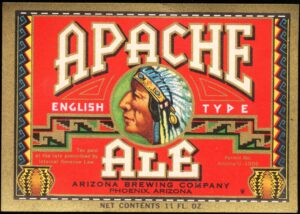
At this point I want to shift gears for a bit and tell a few stories about the Arizona Brewing Company’s (1-Prescott, 2- SE AZ, and 3- Phoenix), The capture, transport, and imprisonment of Naiche (or Nachez), Geronimo and more than 500 Apache in Florida by late 1886, and some incredible coincidences involving famous artists and researchers of this time in the Southwest.

The newly formed Arizona Brewing Company (#3) sprang to life in Phoenix in 1933 as soon as prohibition was repealed. Being a new brewery they did not exactly have a signature brand to promote so they made several different ones of generally short lived names. In June of 1934 they introduced Apache, first on draft, then in bottles, briefly in cans, and then more bottles until WWII curtailed things in 1942 (See Sipos 2013, cited below). As you can see the labels and advertising were really spectacular. In 1943 A-1 beer was introduced and that remained their flagship brand until they were bought up in the 1960s. **edit: In the video I mistakenly said Apache porter- actually Brewing Arizona p104 says they made Apache Bock, must have been only bottles! Now that would be a tough can if only they had….
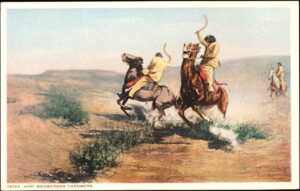
Famed Southwestern artist Alonzo “Lon” Megargee (1883–1960) was a long time fixture on the Arizona landscape. His more formal early work adorns the capital in Phoenix (18 total paintings actually). Between 1948 and 1951 he created a series of great Southwestern themed advertising images for Arizona Brewing and their A-1 brand. Large framed prints of four of them are today highly collectible (and would look great at P2P’s headquarters if you have any available? see Sipos 2013:120-122)- I have postcards showing two of them- Black Bart is shown below.
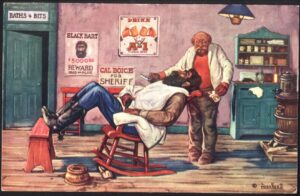
Prior to the commissions for the brewery Lon had purchased land in Paradise Valley in 1935 and built a southwestern gem of various buildings that today is thriving as the Hermosa Inn https://www.hermosainn.com/about-hermosa-inn/history A divorce in 1941 led to him selling the place with art and furnishings included and this is where the story gets interesting. Then called La Casa Hermosa it was purchased by a then unknown middle aged English teacher and WWI widow named Eve Ball (14 March 1890 – 24 December 1984).
She ran the Hermosa Inn as a dude ranch very briefly and moved to Ruidoso, New Mexico in 1942, probably in part so she could write more. Later she even wrote an article about Lon Megargee. Over time she developed trust and rapport with the Mescalero and Chiricahua Apache living there and was able to interview descendants and relatives of Geronimo, Victorio, Nana, and Juh, among the many who helped her preserve their oral histories. Asa “Ace” Daklugie, Juh’s son and a nephew of Geronimo, became a particularly close, prominent friend whose involvement with her helped bring in other more reluctant informants. All of which developed into three very famous books and more than 100 articles on the Apache, largely from their perspective. Something unheard of when she began. Ace Daklugie was 17 when the last of the Chiricahua surrendered in 1886. He spent 27 years as a POW in Florida, Alabama, and Oklahoma before being allowed to return to New Mexico in 1913. Please see any of a number of works by Lynda Sanchez for biographical information on Ms. Ball and her writings.
Late in August of 1886 Naiche, Geronimo and the other 30 or so Chiricahua Apache still actively fighting Mexican and American invaders of their land agreed to return to America and surrender to General Nelson Miles. The formal surrender occurred Sept 4th, 1886 at Fort Bowie in southeast Arizona. Some accounts conflate different actions and have stated that these people were put in wagons and sent north for two weeks through the San Carlos reservation, adding 65 more POW’s and shipping them east from Holbrook, AZ. This certainly happened to some Apache at the very same time but not Naiche’s band.
To this group of 32 Apache, were added to the train at the last minute, the two Chiricahua scouts, Martine and Kayitah, who actual found Geronimo and got them to talk of peace. They were sent by train from Fort Bowie Sept 8, to San Antonio, Texas, arriving there at 1pm, September 10th (San Antonio Daily Express, Sept. 11, 1886) where they were to be held until President Cleveland and the Army decided if they would continue to Forts Marion and Pickens of St. Augustine and Pensacola respectively, as POWs, or if they would be tried as civilians in Arizona or maybe Texas. Naiche’s band spent six weeks at Fort Sam Houston outside San Antonio. During this period they were considered something of a sensation and on occasion were treated well. For some reason Geronimo, Naiche, and several others were brought on a tour of the Lone Star Brewery between the 11th and 22nd. Meaning that they had been in Mexico, fully armed, fighting and raiding, “enemies” of Mexico and America, and less than 3 weeks later are in the middle Texas on a brewery tour. It had to be one of the strangest culture shocks they experienced at the beginning of their shameful 27 years of captivity.
Finally, to come back to the beginning after a fashion, in one of those strings of historical connections that can only happen in real life because if it happened in fiction it wouldn’t be believable- About 1871 as a 13 or 14 year old teenager James Cook, remember him?, arrived in San Antonio, TX looking to make his way in cattle or however he could. Somehow he was befriend by Bigfoot Wallace, and later received a fine horse from him. About this time he started working for another famous Texan, then New Mexican, then Arizonan, John Slaughter.
Slaughter is most famous in Arizona as the hard nosed Sheriff of Cochise Co from 1887-1890. And….trying to form a brewery in the southeast corner of the state at the end of 1903, even selling and issuing stock in 1904, before the project fell apart, in what would have been the second Arizona Brewing Company going at the time (the one in Prescott was much more successful for 20+ years). Cook’s story is told in Longhorn Cowboy (1942 w/Driggs) and the previously unknown tale (in the beer world I believe) of John Slaughter’s failed Arizona Brewing #2 was told by my friend Ed Sipos in his excellent book Brewing Arizona from 2013:68-70, which is my main source for Arizona Brewing Co #3 info as well. So the take away message seems to be that anything interesting that happened in the history of Arizona is no more than one degree of separation from beer. Yeah, that must be it!
You are cordially invited to take a look at a companion video with some Arizona Breweriana, including Lon Megargee’s art, and original Apache photographs on my Paleo to Pioneer Youtube channel at https://www.youtube.com/channel/UCFLm3k7KkstmNGXIl6oGb6A
Thanks for reading, and a special thank you to Dr. Clark Wernecke of the Gault School of Archaeological Research for lots of help chasing down original sources, Andy
* The correct name is Dead Horse Gulch, not Wild Horse Arroyo which was incorrectly applied years later. Tony Hillerman was exactly right about the name. The specific details of this minor controversy are documented within an article I need to revise for publication.
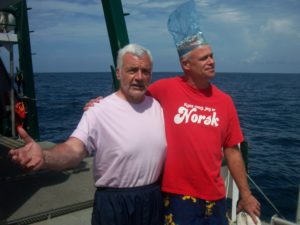
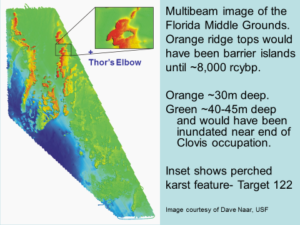
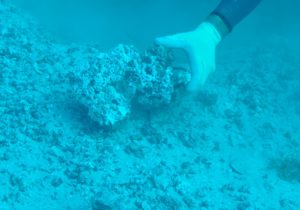
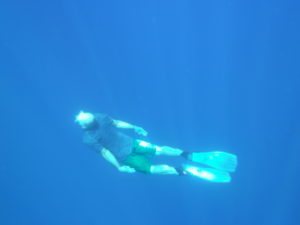
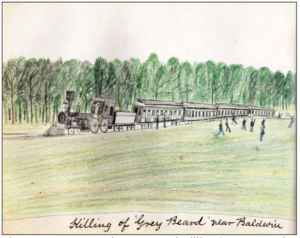
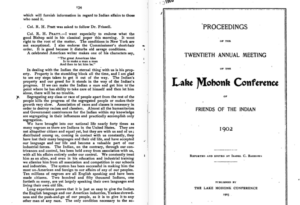
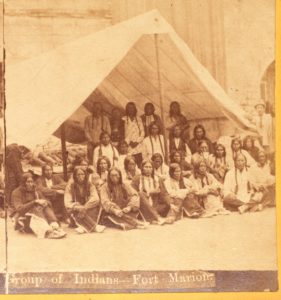
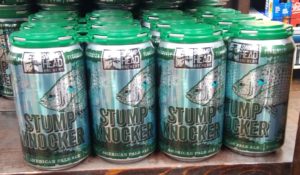

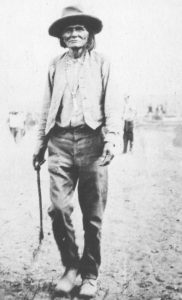
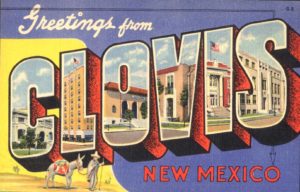
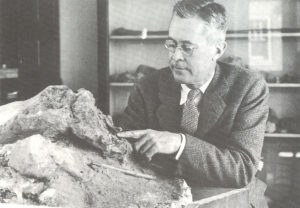
Recent Comments